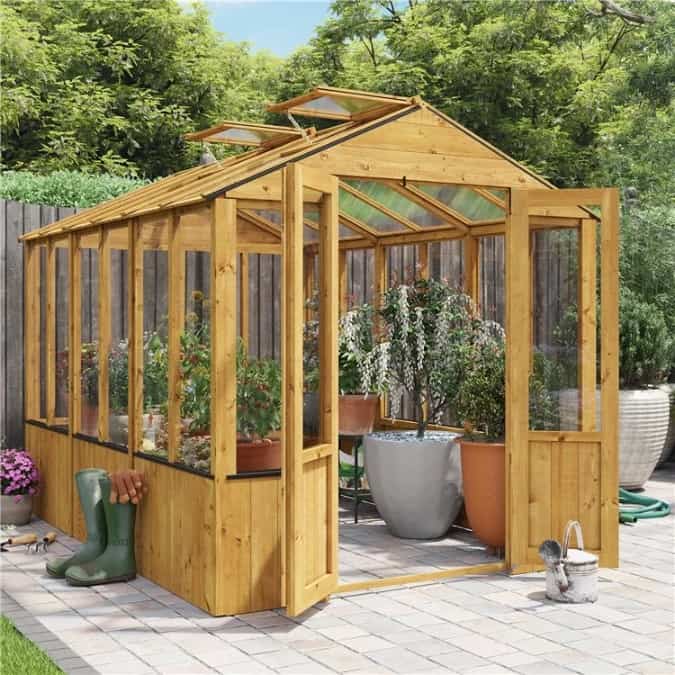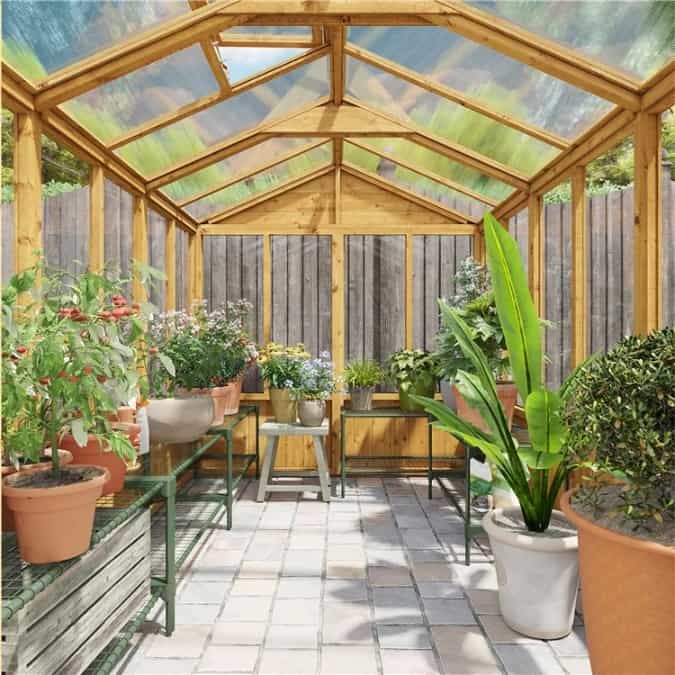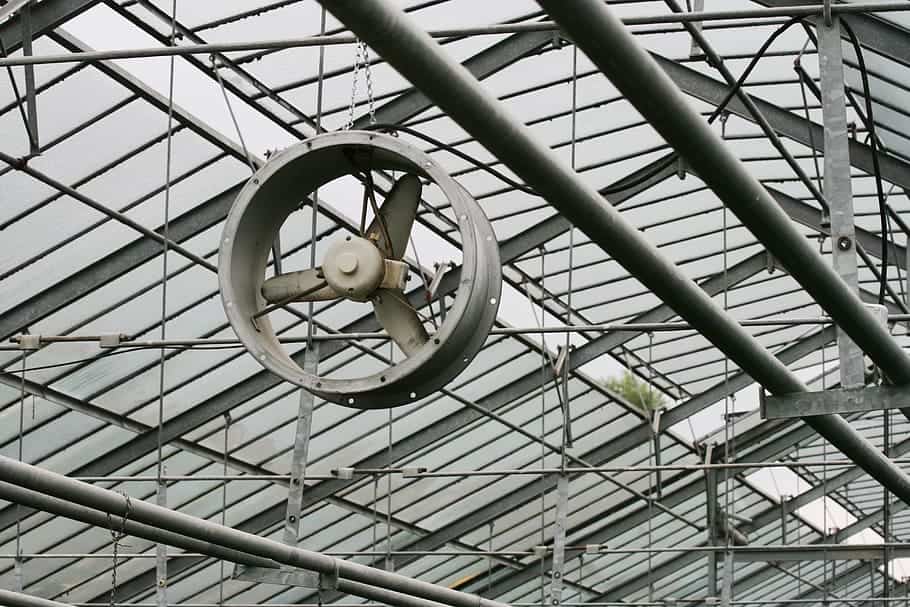Jump to:
A perfect environment for plants is crucial for their health and growth. One of the key factors in maintaining an optimal greenhouse environment is ventilation. By effectively ventilating your greenhouse, you can create an ideal haven for them.
In this blog, we’ll delve into this importance and provide you with practical tips on how to achieve it. Keep reading!
Understanding Greenhouse Ventilation

Ventilation creates and maintains the ideal environment within a greenhouse. It facilitates air exchange between the inside and outside of the structure. Overall, ventilation helps regulate temperature, humidity, and air circulation. These factors are vital for the health and productivity of your plants.
Ventilation aids in temperature control. During sunny days, the temperature inside a greenhouse can rise rapidly, no matter what type of material it’s made from. This could potentially exceed the optimal range for plant growth. Through ventilation, it helps prevent overheating, keeping the temperature within a desirable range. In colder seasons, ventilation prevents excessive cooling, ensuring the plants stay warm.
Ventilation also assists in humidity regulation. Greenhouse environments can become excessively humid due to plant transpiration and water evaporation. High humidity levels can promote fungal diseases and hinder plant development. Effective ventilation helps remove excess moisture from the air. It maintains a balanced humidity level and reduces the risk of plant diseases.
Finally, ventilation promotes air circulation within the greenhouse. Stagnant air can lead to a buildup of pests and uneven humidity distribution. By allowing fresh air to circulate, ventilation helps prevent these issues. It ensures that plants receive enough supply of carbon dioxide for photosynthesis.
A well-designed ventilation system will address these aspects. It creates a favourable environment that fosters healthy plant growth.
Types of Greenhouse Ventilation Systems
Below are the two common types of greenhouse ventilation systems:
1. Natural ventilation

Natural ventilation utilises passive methods to facilitate airflow in the greenhouse. It relies on the principles of convection and wind to exchange air. The concept of passive ventilation involves vents, windows, and louvres.
These openings are strategically positioned to take advantage of the following:
- prevailing winds
- temperature differentials
When the outside temperature is lower than inside, warm air naturally rises and escapes through the vents. Such instances create a suction effect that draws in the fresh air. This system is cost-effective and energy-efficient. For one, it operates without the need for electricity or mechanical components.
Our wooden greenhouses have an optional opening vent which make aerating your greenhouse super simple.
2. Mechanical ventilation

(Image Credit: Wallpaper Flare)
Mechanical ventilation involves active methods of air movement in the greenhouse. This system utilises fans, exhaust systems, and cooling pads to ensure efficient airflow. Fans are used to circulate air and maintain a uniform temperature and humidity level. They can be installed to either blow air into the greenhouse or extract stale air. Exhaust systems, such as exhaust fans or vents, are used to remove hot air from the greenhouse.
Additionally, cooling pads or evaporative cooling systems can be incorporated. They can help lower temperatures by passing incoming air through a wet pad. This, in return, results in evaporative cooling. These are especially useful in metal greenhouses and polycarbonate greenhouses.
Both natural and mechanical ventilation systems have their advantages. In fact, they are often used in combination to achieve optimal greenhouse conditions. But the choice between the two can depend on factors such as climate, greenhouse size, and budget.
Greenhouse Ventilation Strategies

Here are practical strategies for achieving proper ventilation in a greenhouse:
Temperature-based ventilation
To use temperature-based ventilation effectively, employ temperature sensors and thermostats within your greenhouse. Place temperature sensors at different levels to monitor temperature variations accurately. Connect these sensors to a thermostat or a controller system.
When temperatures exceed the optimal range, the thermostat will activate fans or open vents to release excess heat. Conversely, when temperatures drop too low, the system closes vents or reduces fan speed to retain warmth. Regularly calibrate the sensors and thermostats to ensure precise temperature control.
Humidity-based ventilation
Maintaining optimal humidity levels in the greenhouse is crucial for plant health. Hygrometers and humidistats are essential tools for monitoring and controlling humidity. Hygrometers measure the humidity level in the greenhouse. Meanwhile, humidistats act as controllers that activate ventilation equipment based on humidity thresholds.
Set the desired humidity range in the humidistat, aligning it with your plants’ needs. When humidity levels exceed, the system will activate fans or open vents to expel excess moisture. And when humidity drops below the set range, the system will adjust to retain moisture. Always check the hygrometers and humidistats to maintain accurate readings.
Timed ventilation
Timed ventilation offers the convenience of automated and scheduled airflow in the greenhouse. This approach ensures consistent and regular air exchange. Set up timers for fans, vents, or other equipment based on your greenhouse’s needs.
Schedule ventilation cycles to occur during specific times of the day. Especially on days when temperature and humidity fluctuations are most likely to occur. This timed approach provides a proactive solution to maintain an optimal plant environment. Adjust the timers as needed according to seasonal changes or specific plant requirements.
By implementing these practical strategies, you can achieve proper ventilation in your greenhouse.
Round-up
Proper ventilation is the key to maintaining a healthy and thriving greenhouse environment. To provide your plants with the optimal conditions for growth and productivity, consider:
- controlling temperature
- regulating humidity levels
- promoting air circulation
Understanding the different options allows you to design the ideal ventilation system. Remember to monitor regularly. Adjust your ventilation system to adapt to changing weather conditions. Also, make sure to consider the evolving requirements of your plants. With this you can keep the interior of your garden greenhouse at the ideal temperature and allow your plants to thrive.
Happy gardening – and, if you’ve not got a greenhouse of your own yet, check out our selection below!
Shop Greenhouses




